Hurricane Michael—The Aftermath
I’ve spent several days since Hurricane Michael hit the Florida coast down that way, surveying damage in Northwest Florida and Southwest Georgia. Having grown up in the coastal plain of Virginia, I’ve seen my share of hurricane damage from Floyd, Isabel, etc. However, I’ve never seen the level of damage I’ve witnessed due to this storm, which will certainly go down as one of the costliest storms in terms of agricultural losses. But to put it in perspective, sustained 100 mph winds were witnessed almost 125 miles inland, well into Georgia. Amazingly, initial plant losses (death) when I visited three days after the storm were minimal, with damage being mainly structural in nature. Cold frames took a beating, as well as shade structures and barns/storage sheds. Any exposed ground cloth was ripped up and in the process, many irrigation heads were broken off.
Fast forward two weeks, and damage to plants is becoming more evident, with losses averaging about 15% at the hardest-hit nurseries. The majority of losses are due to trunk (cambium) damage on trees and shrubs, with broken twigs and resulting misshapen canopies. In talking to growers, all indicated they were going to be able to easily fill existing orders. With a little more labor in shaping plants/pruning, and a good spring flush, I’d say I agree with them; many losses are difficult to swallow, but this could have been so much worse.
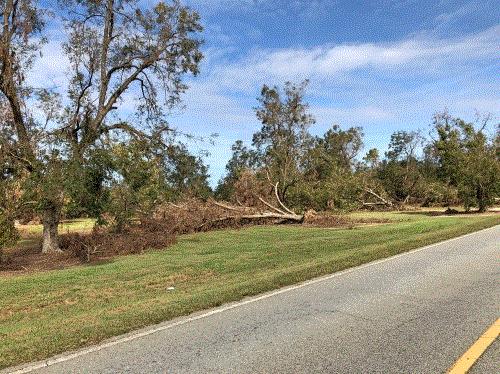
My heart breaks for the pecan industry. Many growers in the affected region lost 100% of trees, which will take a minimum of 12 years to replace and get to a point of producing a crop. This photo was taken near Cordele, Georgia, 175 miles inland from the point of landfall.
Don’t believe me … just ask the pecan folks.

To Insure or Not to Insure
When it comes to insurance for nurseries, it’s a no-brainer that structures and road-worthy vehicles need to be insured. But what about insuring plants? Do you assume that disaster assistance programs are available through the USDA Farm Service Agency, like the Tree Assistance Program (TAP), which will offset losses? Well, if you rely on the TAP, then be aware that it only covers replacement value of the liner/seedling—nothing more. The Wildfires and Hurricanes Indemnity Program (WHIP) is another program that many growers assume will offer assistance. But to date, it has not been extended by congress to cover losses in 2018. And on top of that, 13 months after Hurricane Irma, less than 10% of claims under WHIP have been paid—so don’t expect anything quick.
This circles us back to the issue of insurance on live goods. It’s always a good idea to contact your local risk management agency to discuss insuring your crops, because currently, a 50% loss policy’s premiums are subsidized. Above the 50% loss (called buy-up coverage), prices can get very expensive quickly. At that point, it is more of a personal choice as to what you do. However, when I am consulting with growers on this question, I generally suggest insuring when:
-
You're in a region where natural disasters are common. I define "common" as having a nursery within 50 miles of an area that has suffered catastrophic losses in the last 5 years.
-
You do not have enough in savings to cover losses.
-
Contract growing represents a significant amount of your income.
-
A significant percentage of your plant material is booked out six months or more.
-
Your psyche causes you to have significant stress related to the thought of catastrophic losses.
Ultimately, I get the question, “What would you do?" I would obtain at least 50% coverage, because I suffer from anxiety and I would lose sleep if I didn’t. I’d also just include insurance as a production cost, because it stings a little less if you think of it in terms of pennies per plant versus a check for thousands of dollars annually.

Katsura Tree
While texting back and forth last week, my graduate student Mary Lewis said, “I’ll write about two taxa for the newsletter." And considering I am not going to turn down help, I gladly accepted her offer. She’s also a pretty snazzy and upbeat writer-in-training. So without further delay, take it away Mary …
Fall here in Athens is one of my favorite times of the year, mainly because whoever landscaped the University of Georgia did a magnificent job of planting material with amazing fall color. Is this a biased opinion? Heck yes. One tree in particular makes my day whenever I get the change to pass by it: Cercidiphyllum japonicum, or Katsura tree. While not a native to the U.S., it performs well in zones 4-8. A fully mature tree can grow to between 40 to 60 ft. tall, and as the name suggests, it has cordate-shaped leaves like the redbud it’s named after. This time of year the foliage turns from a bluish green to a yellow or apricot orange before falling. Best part of this tree though? The fallen foliage—hands down. People say the smell of the leaves is like cotton candy, but to me they smell more like vanilla than anything else. What makes this tree so much fun though is just picking up the leaves and sniffing them—and no, you don’t look strange at all doing this out in public. You have to frolic through the leaves themselves to elicit that sweet aroma. So not only do you get to revert to your inner child and revel in the joys that autumn and cooler weather brings, but you also become surrounded by the subtle sweet scent of the fallen leaves. If that’s not enough to tempt you, new foliage in the spring is a reddish purple (again, akin to a redbud), the bark is somewhat shaggy, and as long as sufficient water sources are nearby, they can happily withstand full sun to partial shade.
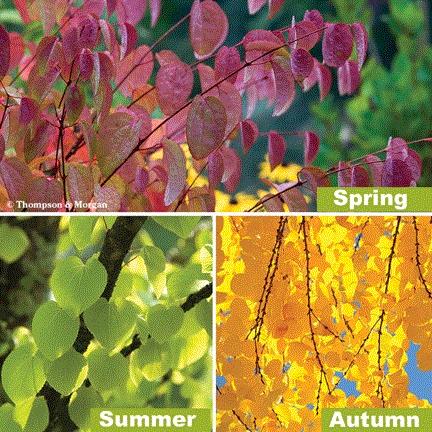
It’s also pretty much disease free! No pervasive leaf rusts, pest issues, fungal infections; this is a relatively hassle-free tree in the grand scheme of things. Asking me to choose a favorite cultivar is like asking me to choose my favorite dog—all are amazing and I just can’t, so don’t ask me. But if you’re not into the straight species, Pendulum is a weeping cultivar that is visually stunning, and still will obtain a modest 25 ft. in height.

Boxwood Blight Found at Indiana Garden Center
It’s pretty bad news for folks in Indiana, as Purdue University and Indiana’s Department of Natural Resources, Division of Entomology and Plant Pathology announced in mid-October that container boxwoods at a number of retail outlets have tested positive for boxwood blight. The infected plants have been linked to a shipment of infected boxwood plants that were shipped to Indiana in May.
This is important because boxwood blight (Calonectria pseudonaviculata) is a fungal disease that infests members of the popular Buxaceae family, and is often transported through the nursery trade. Hosts include Buxus (boxwood), Pachysandra (Japanese spurge) and Sarcococca (sweetbox).
In total, 23 stores in Indiana received infected material in early spring (particularly the cultivar Graham Blandy), and it’s possible that landscape contractors inadvertently purchased some plants. If you did, or suspect you have, please contact your respective DNR staff member.
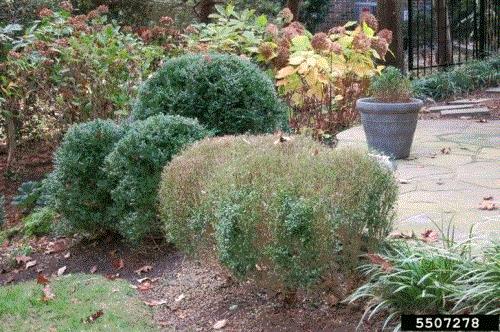
Unlike most pathogens, boxwood blight results in massive leaf drop, which happens quite suddenly (as in 24 to 48 hours).
The fungus, which can lay dormant in drier conditions, can be found on all above-ground portions of the plant and presents itself as dark leaf spots. It causes rapid defoliation, which typically starts on the bottom of the plant and moves toward the top. This fungal pathogen can move through sporulation in water and from dropped leaves. As a result, infection can spread to surrounding plants from a single infected plant.

PanAmerican Seed 2020 Sneak Peek
On October 1, PanAmerican Seed released a select group of new 2020 introductions for sale. This provides growers a chance to purchase larger quantities and sell the latest seed genetics during the 2019 spring season rather than only offering small quantities for sampling. This early-release timeline closes the loop on the company’s strategy to trial with growers before introduction to confirm performance, and encourages growers to use the best new varieties a year in advance of traditional availability timelines.
“It is important that our customers have access to our newest genetics as soon as we have the seed in stock, along with relevant growing information and marketing support. We are excited to offer 31 new varieties a year ahead of the traditional industry timelines,” says Scott Rusch, Product Development Director at PanAmerican Seed. “The improvements that our breeders, product managers and trial collaborators have seen for the last several years solve key grower challenges. We also have several innovative new products that will help growers generate interest with consumers and landscapers.”

Of the 2020 releases, I'm partial to Cool Wave Strawberry Swirl pansy. Just a killer color combination!
To see the full list of 2020 early sales products, visit www.panamseed.com/newvarieties. Watch for further 2020 releases in the new year and closer to California Spring Trials in March 2019.

Bailey Buys Carlton
This falls into the ‘all in the family’ category. As of October 31, Carlton Plants will officially have new ownership under the Bailey Nurseries label. But many folks don’t know that Carlton has, since the mid 80’s, been owned by members of the Bailey family (Gordon Bailey Sr., and more recently, his grandson Jon Bartch). That continuity should definitely foster a smooth transition, which will occur over several years.
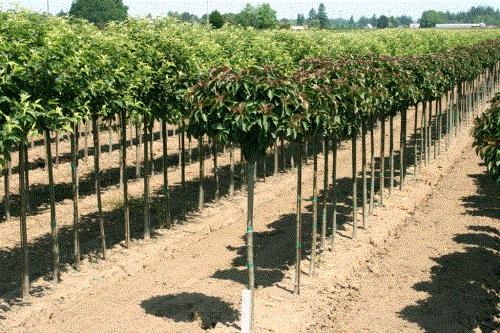
Carlton Plants has long been known as a magnificent grower of bareroot plants. The thing that struck me about the nursery when I visited is how darn clean the place was.
The larger question for many is, will this affect production levels at Carlton or orders placed for 2019? In short, nope. There aren’t any indications production will be scaled back and so there aren’t any worries moving forward and all orders will be honored going forward. In fact, with both companies having similar production methods that provide similar products (especially bare-root material), it should actually make the transition quite easy. There certainly won’t be much of a learning curve as Carlton transitions to Bailey.

Ginkgo biloba
Mary’s back at it. And yes, she is definitely my kid when it comes to writing sarcasm and humor.
I’m a UGA girl, Athens is like home, and our city tree is Ginkgo biloba. If those aren’t enough qualifications to make this tree a needed addition in your yard, here are a few more. Hardy from zones 4-9, this prehistoric ancestral tree can reach heights between 50 to 80 ft. (though most cultivars top out around 35 to 45 ft.) and possesses fan-shaped leaves that are a vibrant green for most of the year. The advent of fall turns this majestic tree’s leaves a bright, happy golden color. What really makes me adore this tree is that unlike most deciduous trees that drop their leaves over time, Ginkgos hang on to them for a while, and then drop all their leaves at once. It’s the coolest thing to be walking to class one day and all the trees have golden leaves on them, and then the next you’re walking on a carpet of golden leaves. Doesn’t it make you feel like royalty? Why yes, yes it does.
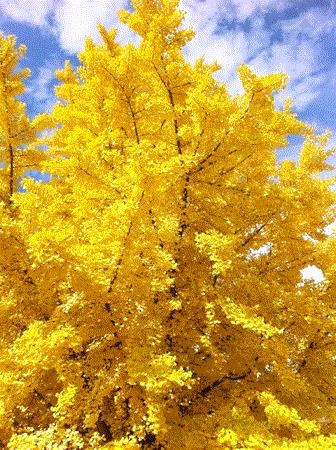
Ginkgo Presidential Gold is a winner, with toughness and outstanding fall color.
Another tree with pretty much negligible disease or pest issues, it takes full sun to partial shade conditions and is a hardy city tree. The only downside is you MUST have the male form. This is a dioecious species (separate male and female trees), and the female will produce fruit that smells absolutely terrible. While good for throwing at your ex, the fruit has little other landscape value. Somewhat akin to the after effects of a major fraternity party on a Saturday, sidewalks and roads can be littered with the foul-smelling fruit, and therefore all precautions must be taken that the Ginkgo you plant is an accredited male tree. For favorite cultivars, you’re asking an extremely biased person here, but Presidential Gold is a cultivar commercialized from a seedling on UGA’s campus outside the President’s residence (hence the name). It’s the densest branched Ginkgo cultivar in production that I know of, and it’s one of the most “bang for your buck” cultivars when you talk about fall color. There are many dwarf cultivars that also hold a special place in my heart, but my favorite cultivars are the ones as large and majestic as I imagine they were 150 million years ago. Unless they were regularly pruned by dinosaurs and didn’t actually get very tall. That would be incredibly disappointing!

Our Wacky Wonderful World—Notes from the Edge of Sanity
A week ago today (Monday), I sat in an auditorium in Tifton, Georgia, and listened to representatives from USDA, FEMA, U.S. Forest Service and Farm Credit present resources available to agricultural producers after a hurricane. I’ve heard similar presentations after a disaster for the last 20 years, and it frustrates me each and every time. Specifically, it burns me up to sit and listen to row crop producers complain about not receiving 100% subsidized payout (depending on crop it can be as high as 85%) after a disaster while specialty crop producers are lucky to get 50%. And while USDA programs like the Tree Assistance Program (TAP) are in place, they only cover a tiny fraction of the replacement cost (the liner itself is all TAP covers).
Ironically enough, in 2018, the Wildfire and Hurricane Indemnity Program (WHIP) passed, which offers more substantial assistance to those who suffered damage in 2017. But in speaking with growers who were affected by wildfires or hurricane damage in 2017, virtually none who filed a claim have seen a penny from this program. At the meeting in Tifton, Georgia, Rep. Austin Scott revealed why growers haven’t seen much (if any) payout from WHIP, after announcing there is a push to carry the program forward for those with damage in 2018. It centers around the company contracted to write the computer program that USDA uses to input claims, and the fact it is pretty much useless as it pre-populates nothing. The result is that a USDA employee has to enter everything manually. Yep, hundreds if not thousands of specialty crop producers are suffering significant financial issues a year or more after the natural disasters of 2017 because of a computer program that I wager five undergrad computer science students could construct for a keg of PBR and 10 pizzas. You can’t make this stuff up, folks.
So what’s the moral of the story here? Number one, have a backup plan in case of a natural disaster that does not force you to rely on government assistance to make it to and through the following year. Number two, those in specialty crop agriculture need to seek common themes to create change that levels the playing field when it comes to receiving USDA assistance. I know AmericanHort and the National Association of Landscape Professionals (NALP), as well as many state associations, work hard to find commonalities among specialty crop agriculture segments to lift all segments in the eyes of federal and state government. But it’s going to take a lot more than our associations fighting on our behalf—it’s going to take each of us conveying a uniform message to enact change (AmericanHort and NALP both have websites devoted to the most pressing issues). And what a perfect time to do so, as negotiations on the next farm bill are on the immediate horizon.

Live authentic,

Matthew Chappell
Editor-at-Large
Nursery & Landscape Insider
This has been received by 30,421 of the hardest-working horticulturists in show business!
If you're interested in reaching 30,421 (and growing) clients who eagerly await every Nursery & Landscape Insider and surely read every word, contact Kim Brown ASAP and she'll hook you up. And thanks for helping us reach a community of 30,000+ fellow horticulturists! Keep spreading the word.